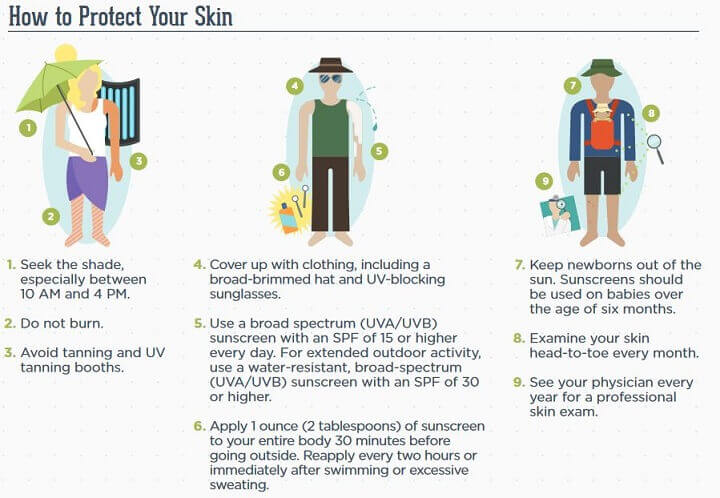In the warm weather, it’s great to be able to move many fitness activities from the gym to the great outdoors. There’s nothing better than biking or hiking through natural trails, running on the beach or enjoying a refreshing swim on a hot day.
But outdoor exercising has some risks and hazards, too … stronger sunlight and the heat are right in the forefront of risks you should prepare for and take steps to mitigate so that your fitness activities will be safe and fun.
Sun exposure
It wasn’t all that long ago that dark tans were the mark of athletes and celebrities, but most of us know better now … sunburns and tans cause damage to your skin because ultraviolet rays are a form of radiation. In addition to prematurely aging your skin, one of the biggest risks is for developing skin cancer. Many people think that they are low risk because they tan easily or because they are young – these are just a few of the many myths that foster a false sense of security. Check out 10 skin cancer myths, debunked for more.
The Skin Cancer Foundation (SCF) offers facts, statistics, prevention advice, warning signs, and many more valuable resources. They advise that when you’ll be out in the sun, protective clothing is your first line of defense and the more skin you cover, the better. But not all fabrics are equal – some have properties that strengthen your protection. Learn about buying sun-safe clothing in colors and fabric that offer protection. Sportswear manufacturers are offering more and more sun-safe clothing options so if you exercise outdoors frequently, you may want to learn more.
It’s also very important to use sunscreen anytime you’ll be out in the sun. Although most people are aware that they should apply sunscreen, many people don’t use it properly. SCF offers a broad array of sunscreen resources, including advice on how to read a sunscreen label.
We’ve featured a graphic from SCF. Read and share their prevention guidelines with those you love.
Dehydration and heat illnesses
The second big bucket of weather-related seasonal risks goes hand in hand with the sun: Dehydration, heat cramps, heat exhaustion and heatstroke. In the hot weather, your motto should be “hydrate, hydrate, hydrate” particularly when exercising.
In heat waves, it is far better time your strenuous activities like running or tennis to early morning or early evening hours when its cooler and the strongest rays of the sun do not add to your risk of dehydration.
With heat exhaustion, your body temperature rises, your pallor may either get pale or flushed, and you may experience dizziness, nausea, weakness, fever, headache, dry skin, cramps, and rapid pulse.
It’s very important to learn the symptoms of heat exhaustion and how to recognize them in yourself or others. Heat exhaustion needs to be taken seriously because left untreated, it an lead to heat stroke, which is a life-threatening condition. The Mayo Clinic offers advice on heat exhaustion first aid. The CDC offers great resources on extreme heat and your health.

